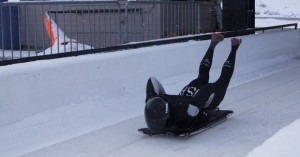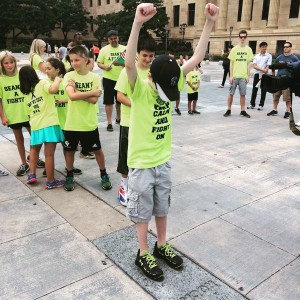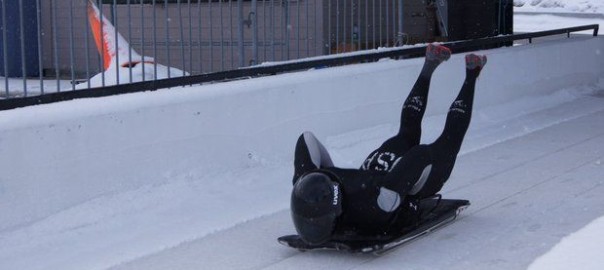Is it, Seun Adebiyi, cancer survivor? Or international cancer activist? Or author? Or Olympic hopeful? Or, most incongrously, Seun Adebiyi, Winter Olympic hopeful from Nigeria?
 Adebiyi, Nigerian-born and raised in Huntsville, answers to all those.
Adebiyi, Nigerian-born and raised in Huntsville, answers to all those.
A talented swimmer in his youth, he barely missed making Summer Olympic teams. Then – light bulb moment! – he decided on the preposterous notion to create a Winter Olympics team for “acountry that doesn’t have winter.” He chose the skeleton, the small sled that zips down a curved, banked course where “you get a running start, do a belly flop and hold on for dear life.”
That’s what Adebiyi has been doing for most of his 32 years, even when snow wasn’t even anywhere in his life.
His mother, the Oxford-educated Dr. Bimpe Adebiyi, brought him to Huntsville when he was six, leaving her post as a dean at the University of Sokoto to study at Mississippi University for Women, then moving to Huntsville to work as a professor at UAH and, later, at Alabama A&M.
In the meantime, young Seun was “a rambunctious kid” in his words. Or, as Bimpe recalls a family friend’s description, “one of those made-in-China toys where the spring is broken and it just keeps going.” To burn off some energy, she enrolled him in a local swimming program, where he began to excel.
He transferred from Huntsville High to Jacksonville’s Bolles School as a senior to accelerate training for the 2000 Olympics, but an injury derailed him. He enrolled at the University of Pittsburgh, earning a degree in math and classics while training for the 2004 Games; alas, he missed by one-tenth of a second.
Adebiyi was accepted at Yale Law School. That’s where a life-altering barbecue was held. He gathered some friends to brainstorm over his best Winter Olympic possibility for 2010. After watching some winter events on YouTube, the skeleton was the consensus.
He went to a training run in March 2009 in Lake Placid, N.Y., where “basically all they did was hand me a helmet, said, ‘Your head goes here. Here are the handles. Hold on tight.’ And they just shoved me down the track.”
He is not a risk-taker or adrenaline junkie. But “I got to the bottom and I went, ‘I’ve got to try that again,” Adebiyi says. “I had a chance to make sports history.”
Then came cancer.
It was a week after he graduated from law school and a week before his 26th birthday when he was diagnosed with two aggressive forms of cancer, This wasn’t a training injury or a too-slow time to keep him from the Olympics. This was life and death, as he’s recently detailed in a first-person story on “The Players’ Tribune,” a website founded by Derek Jeter.
While competitors were hurtling downhill in Vancouver, he was watching in an isolation ward, having gone through radiation and a stem-cell transplant, “beat up and (I) pretty much had one foot in the grave.”
Seun Adebiyi is a cancer survivor who is hoping to qualifying for the next two Olympic Games. His mother, Dr. Bimpe Adebiyi, a Huntsville resident, talks about her son.
Adebiyi was also resolute, vowing, “If I get out of this bed, I’m going to take that second chance and run with it. That’s what drives me now. God gave me a second chance and I’m just going to run with it.”
Out of the hospital but so weak that others had to carry his 80-pound sled to the course, he moved to Utah to resume training. As he writes in The Players’ Tribune, “I definitely was being a little crazy. … But I had nothing to lose. The way I saw it, I already had cancer, what’s the worst that could happen?”
He has since left his job as a corporate attorney to work for the American Cancer Society, traveling the world to 30 different countries to help fight cancer.
“A lot of other countries don’t have access to the resources we take for granted,” he says. “We were working for poorer countries to get the same access to treatment.”
Adebiyi has scaled back the travel as he trains for another Olympic bid. This time, he’s giving himself two second chances. He’ll try to qualify for the 2016 Summer Games in swimming, with an eye on 2018 in the skeleton.
“For a long time it was about being the best. I had all these trophies from my swimming days. But after cancer, it’s really changed the motivation for me, to share my story and show cancer isn’t the end,” he says. “I want to be able to change that narrative around cancer. Here’s this guy who had who had cancer very young and it wasn’t the end of his life. In fact he took his life to the next level.”
What intrigue there is, wondering what comes after the next comma.



 Adebiyi, Nigerian-born and raised in Huntsville, answers to all those.
Adebiyi, Nigerian-born and raised in Huntsville, answers to all those.